A Vanderbilt expert shares tips and info about the essential oils health trend gaining popularity.
“25 Essential Oil Hacks” … “10 Things Lavender Oil Can Fix” … There’s a good chance you have one or two friends who fill Facebook and Pinterest with these posts about essential oils. Or maybe your hippie aunt has been trying to get you to use essential oils for years. While they aren’t a cure-all, there may be validity to some of those oil claims.
Blaire Morriss, a nurse practitioner and health coach at Vanderbilt’s Osher Center for Integrative Medicine, counsels and educates essential oil users around research-based practices — and advises taking marketing claims with a grain of salt.
How might be essential oils be used in patient care?
For instance, with pain, there have been studies of lavender being diffused in the air and it being shown to reduce a patient’s pulse and blood pressure and self-reported pain. With pain it’s often something with lavender, marjoram, geranium. Sometimes, particularly in hospice or palliative care, people will do an aromatherapy hand massage. With nausea, they will often use an aromatic inhaler stick or an aroma patch (which can be placed on a patient’s skin or nightgown) and the oils that are used are ginger and peppermint, depending on the patient’s preference.
What essential oils could be helpful at home?
- Lavender is great for stress. It’s been shown to be helpful with pain and in inducing sleep and relaxation.
- Peppermint is also a great starter one, particularly for things like nausea; it helps prevent gas formation, so some people find it’s helpful when rubbed on the stomach in a diluted form for abdominal discomfort or pain. It is used in certain topical preparations for pain as well, particularly for headaches.
- Eucalyptus diffusing or inhaling helps with respiratory complaints and coughs.
- Tea Tree is good for or fighting fungus and acne.
What should be used to dilute essential oils?
Typically, it’s a carrier oil like an organic jojoba oil, sweet almond oil, grapeseed oil; anything used for massage oils are typically used as a diluting factor. You can also dilute in lotions or, if you’re putting the oils in a bath, you can dilute it in something that’s fatty like milk so it won’t just sit on top of the water.
Are there any misconceptions you see with people using essential oils?
People typically believe that essential oils are all very safe because they come from plants. I often repeat to my patients what one of my teachers taught me: “Oils on the outside, plants on the inside.” You can take teas and herbs internally and you’re less likely to have interactions with medications or side effects, but you don’t necessarily want to be willy-nilly taking essential oils internally. Many of the patients I see are doing this without much education behind it.
What else should people know about using essential oils?
I would like people that are using essential oils to at least have some baseline education that is coming from an unbiased source. I’ve seen a lot of education from multi-level marketing companies … from a clinical standpoint, I don’t always agree with some of the practices they promote.
To learn more about essential oils and aromatherapy, contact the Osher Center for Integrative Medicine at Vanderbilt. Osher’s Blaire Morriss also recommends visiting the National Association for Holistic Aromatherapy and the University of Minnesota’s Center for Spirituality and Healing.

